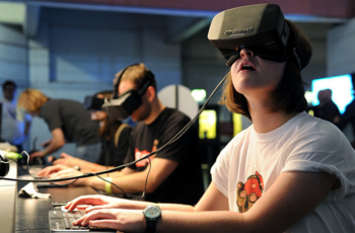Virtual reality and ‘4D’ modelling systems will be at the heart of a major upgrade to Liverpool Lime Street station due to begin next year, in what is thought to be a UK first.

Liverpool Lime Street is the first to use Oculus Rift technology
To prepare for the work, new software is being used to ensure the station is closed for the minimum amount of time. This includes 4D virtual modelling, which allows planners to schedule and coordinate different works across a ‘virtual construction model’.
The 4D technology links 3D models and the construction plan and allows planners to spot potential hazards as well as overlaps and clashes between different teams’ work, prior to deploying resources and machinery on site.
Simon Wray, managing director of Specialist Project Integration, the company that developed the software, said: ‘Liverpool Lime Street is the first rail project in Britain to have a virtual reality model at its core.
‘A unique feature of the system is that it works on multiple formats including mobile devices. Liverpool Lime Street is also the first project to use Oculus Rift virtual reality technology, which allows for a fully immersive experience for training and engagement.’
Graeme Whitehead, Liverpool Lime Street project manager, said: ‘On major projects, where you have people laying track, moving bridges and installing electrical wires overhead, all at the same time, we need precise planning to avoid overlaps that could potentially cause projects to overrun or risk the safety of those working.
'Using this state-of-the-art technology we can spot those clashes before they happen making the project safer and more efficient. This delivers benefits for passengers, taxpayers and our orange army of engineers.’
Visualisation software will also be used to help install new signalling at Liverpool Lime Street instead of having designers go out on the railway and map how the signals could be viewed by train drivers in different trains..
A 3D computer-aided design (CAD) model is created from point clouds and then enhanced using a photographic survey of the site to create a realistic virtual model of the railway.
‘Once the model has been created, specialised signal sighting software is used to make real-time changes at the desktop without the need to send people on to site. The model is then reviewed by experienced train operators to comment or accept the proposed signal locations,’ Network Rail said.
Virtual reality models of both Lime Street’s current and future platform designs are also currently being used to make decisions.
As part of Network Rail’s upgrade plan £340m is being spent across Merseyside.
It costs an average of £200,000 per day to close access to the railway in the Liverpool City Region. The money is paid compensation to train operating companies.
Register now for full access
Register just once to get unrestricted, real-time coverage of the issues and challenges facing UK transport and highways engineers.
Full website content includes the latest news, exclusive commentary from leading industry figures and detailed topical analysis of the highways, transportation, environment and place-shaping sectors.
Use the link below to register your details for full, free access.
Already a registered? Login